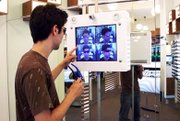The Afterlives of Mannequins
Mannequin styles change almost as frequently as fashion trends, and when retailers want to get rid of last season’s mannequin, they often call a liquidator such as Mannequin Madness. The Oakland, Calif.–based business finds second acts for used mannequins.
The business, formed in 2001, is estimated to handle 300,000 pounds of mannequins annually, said Judi Henderson-Townsend, the company’s president.
Mannequin Madness is one of a handful of companies across the United States that sells and rents used mannequins. Since the last stop for mannequins often is a garbage dump, the Environmental Protection Agency honored Mannequin Madness in 2003 with the agency’s “Environmental Award” for doing its part in keeping the growing tonnage of mannequin parts out of shrinking landfills.
The extension of mannequins’ shelf lives has been good business. This year, Henderson- Townsend added offices in San Diego, Las Vegas and New York City’s Queens borough.
However, the offices are nothing but warehouses where old mannequins rest until they find new homes. People interested in buying or renting old mannequins typically are trade-show exhibitors, independent retailers, fashion designers, and artists and theater groups that use the mannequins in their productions.
From her vantage point, Henderson- Townsend has been able to chart the turns in mannequin trends. Realistic-looking figures are back in style following the popularity of abstract mannequins. Also on the rise are mannequins with Latino, Asian or African features.
Mirror, Mirror
When Brazilian eyewear retailer Chilli Beans opened a boutique in July 2006 at 7619 Melrose Ave. in Los Angeles, it guaranteed shoppers a second and perhaps a third sight.
Like any other boutique, shoppers can check themselves donning new product in the mirror. At Chilli Beans, they can use the added eyes of the boutique’s “Digital Mirror.” The laptop-sized flat-screen computer takes pictures of customers trying on Chilli Beans eyewear. The screen can display up to four images of shoppers wearing different styles. The customers can view themselves from different vantage points, a profile perhaps, which they may not be able to see in a plain mirror. If they want a second opinion, they also can e-mail the images from the Digital Mirror.
Core retail price points range from $30 to $55 for the eyewear. The Digital Mirror is a fixture in the 150 Chilli Beans boutiques in Brazil. The flat-screen monitor often helps close a deal for shoppers buying sunglasses, said sales associate Stefania Kozti. The Digital Mirror may have an added role as an Internet-era picture booth. Groups of people sometimes come to the store just to shoot photos of themselves, Kozti said.
Southern California might see more Chilli Beans boutiques in the future. According to store manager Julio Meliani, his company intends to open 10 boutiques in the next few years.






















